Over the Counter (OTC) Drug Labels Tips for Preventing Unintentional Poisonings
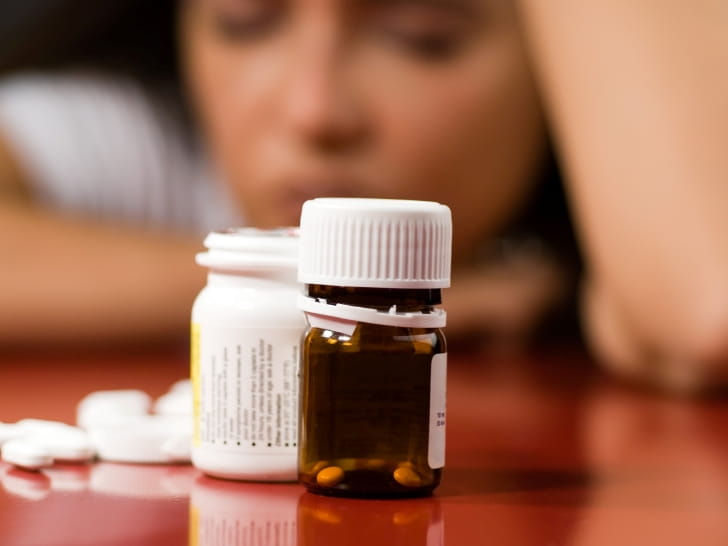
The Bottom Line
The most important part of taking or giving medicine happens before taking or giving that drug: reading and understanding the label. This is the easiest way to prevent errors and overdoses. All over-the-counter (OTC) medication labels contain Drug Facts: important information about the active ingredient(s), uses, warnings, doses, and directions.
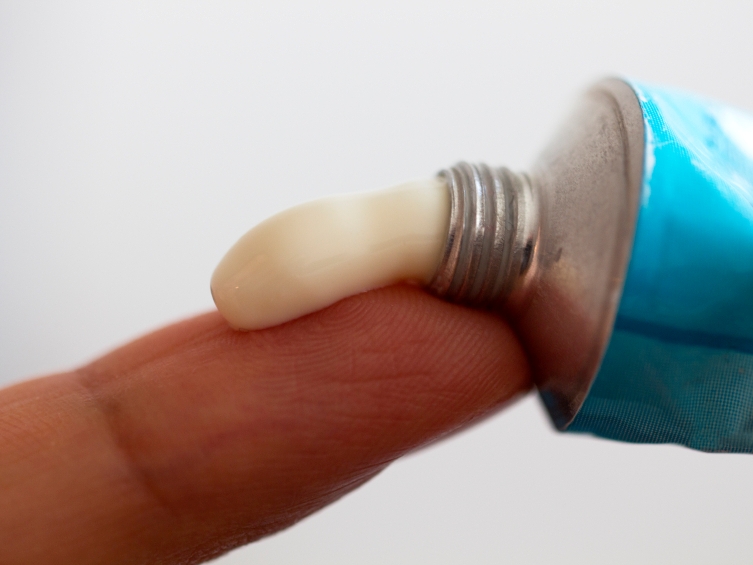
The Full Story
Over-the-counter (OTC) medications are used to treat common health problems: colds and flu, minor aches and pains, fever, allergies and stomach upset. They are available in manyforms: liquids, tablets, ointments, eye drops and sprays, to name a few.
A doctor's prescription is not needed to buy OTC medicines. Even so, they are real drugs. Side effects, drug interactions, and overdoses can occur. Errors with OTC medicines can beserious; they can even require an emergency room visit.
The most important part of taking or giving medicine happens before taking or giving that drug: reading and understanding the label. This is the easiest way to prevent errors andoverdoses, because OTC medicines are often used without health professional advice.
All OTC drug labels include "Drug Facts", the who, what, how, when, and why of that medicine. The Drug Facts tell you what you need to know to give the right drug, in the rightdose, to the right person, at the right time, in the right way, and for the right purpose. The exact location of this important information will be different from product to product.Labels on small containers may have to be peeled back to be completely read.
Here are examples of important information on OTC medicine labels:
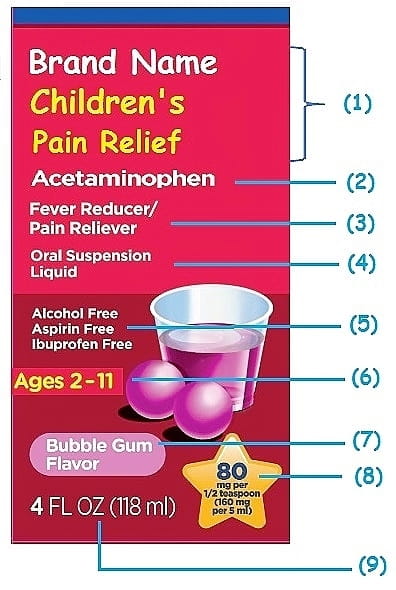
The front label of an OTC medication is an overview. (Look elsewhere on the label for detailed information about giving or taking a drug.)
- The name of the drug (brand or generic) and the reason for taking it.
- The active ingredient. In this example, the active ingredient acetaminophen is clearly stated below the name of the medicine.
- What the drug does. In this case, it reduces fever and relieves pain.
- What form the drug is in. For example, it may be liquid, tablet, ointment, drops, suppository, or spray.
- What the drug is not or does not contain. This label tells you that the medicine does not contain alcohol or aspirin, which should not be given to children. It also does notcontain ibuprofen, a different drug which treats pain and fever.
- If it’s a children’s drug, what ages of children should take it. In this example, children should be at least two and no older than eleven.
- The flavor, especially for children’s drugs. (Flavored syrups, chewable tablets or gummy chews make medicine appealing to children. It might increase the risk of poisoning,though, if children don’t realize that these are medicine.)
- The dose or concentration of the medicine. (Detailed dose information will be found on the Drug Facts part of the label.)
- How much the container holds when full.
Drug Facts:
Every OTC medicine has a Drugs Facts Section. This is required reading before giving or taking a medicine! The FDA requires a standard format for the Drug Facts section. Whetherit is tube of toothpaste or a bottle of allergy medication, the following information must appear in this order:- The product's active ingredients; the amount of active ingredient in each dosage unit.
- The purpose of the product.
- The uses (indications) for the product.
- Specific warnings.
- Dosage instructions--when, how, and how often to take the product.
- The product's inactive ingredients.
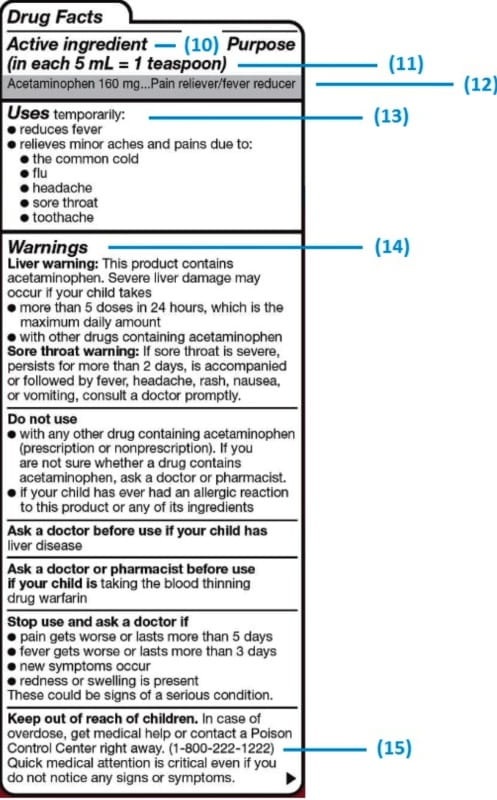
10. The active ingredient answers the "what" question – what medicine are you giving or taking?
- Many OTC drugs contain more than one active ingredient. Each treats a specific symptom.
- The same active ingredient might be found in more than one drug.
- Pay close attention to the active ingredient(s); don't take more than one OTC or prescription medication with the same active ingredient.
11. The dosage unit for the medication. In this case it is one teaspoon, which is equal to 5 milliliters (mL). In each 5 mL, there are 160 milligrams (mg) of acetaminophen. If a child is given a teaspoon of this medication, the dose taken is 160 mg.
- Measure with a special tool meant for medicines; it could be a spoon or dropper.
- Do NOT use household spoons to measure drugs.
- Be careful to avoid common mistakes, such as mistaking a teaspoon (tsp) for a tablespoon (tbsp), which can lead to a three-fold dosing error.
12. The purpose for taking the medication. In this case, acetaminophen is used to treat pain and reduce fever. This answers the “why” question.
- Pick a medicine to treat the symptoms. For example, if the symptom is a cough, choose a cough medicine. Don’t choose a drug that treats many symptoms. (Some cold and allergy drugs contain three or more active ingredients.)
13. The specified uses or indication of the medication also answers the “why” question. In this example, acetaminophen is indicated for fever and/or minor aches and pains.
14. Warnings. Read and understand the specific warnings about OTC medications. These will tell you:
- when the medication should not be used;
- when you should consult with a doctor or pharmacist;
- what side effects could occur;
- if you should avoid other substances, for example specific drugs or alcohol.
- if you should avoid certain activities, for example driving a car.
15. ALL medicines should be stored out of reach or sight of children.
- OTC medicines are never "child-proof". Child-resistant closures are the last line of defense.
- Poison specialists are available 24/7. Call right away if someone takes too much medicine.
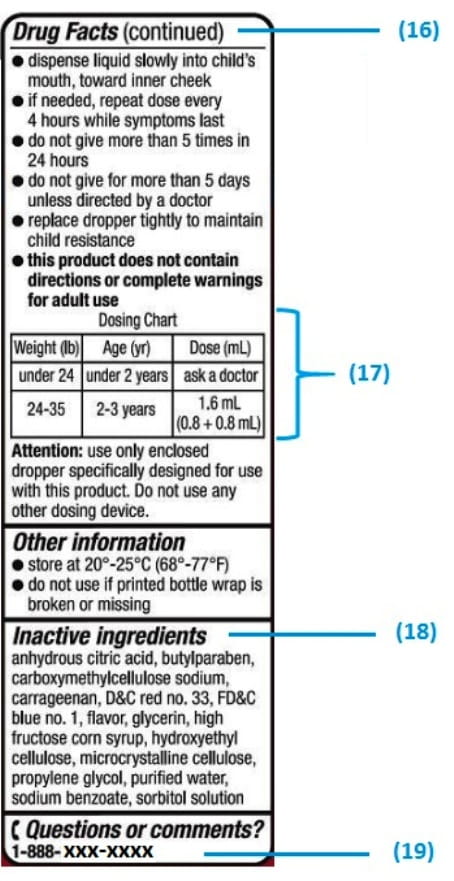
16. "How" and "when" questions are answered here:
- How often to give a dose. In this example, there should be four or more hours between doses.
- How many doses to give. In this example:
- give no more than 5 doses in 2 hours.
- give the medicine for no more than 5 days, unless your doctor gives different instructions.
17. A dosing chart tells how much medicine to give. In this example:
- For children under 24 pounds and under 24 months - ask a doctor.
- For children who weigh 24-35 pounds, and are 2-3 years old, give 1.6 mL.
- Use the special dropper. Do NOT use anything else to measure the medicine.
18. Inactive ingredients in the product aren't meant to treat a symptom.
- Inactive ingredients are mixed with the medicine, so it can be taken easily. Liquid medicines will contain liquids; solid medicines will contain fillers.
- Inactive ingredients may contain coloring agents or preservatives. They are listed for consumers who may be allergic to one or more of them.
19. A toll-free number to the manufacturer of the medication is listed.
- This number is for questions about the medicine, for example, if it looks odd or you can't read the expiration date.
- In case of overdose, medication error, side effect, or drug interactions, use the webPOISONCONTROL® online tool for guidance or call Poison Control at 1-800-222-1222 right away. Poison Control also can help with any questions about information in the Drug Facts section.
Take Home Message
- The most important part of taking or giving medicine happens before taking or giving that drug: reading and understanding the label.
- This is the easiest way to prevent errors and overdoses, because OTC medicines are often used without health professional advice.
- All over-the-counter (OTC) medication labels contain Drug Facts.
- Drug Facts include important information about the active ingredient(s), uses, warnings, doses, and directions.
Serkalem Mekonnen, RN, BSN, MPH
Certified Specialist in Poison Information
Poisoned?
Call 1-800-222-1222 or
Prevention Tips
- Read the entire Drug Facts section of an OTC drug label before giving or taking the medicine.
- If you don't understand the label, call your health provider, pharmacist, or Poison Control.
- When taking or giving a medication, check that you are giving the right drug and the right dose, to the right person, at the right time, in the right way, and for the right purpose.
This Really Happened
Case 1: A 3-year-old child was supposed to get a dose of children's liquid ibuprofen. The babysitter used the measuring cup from the children's ibuprofen bottle. BUT she measured out infant-strength ibuprofen instead. The infant formulation was much more concentrated. [This sounds odd, but it's true: infants can't easily swallow as much liquid as older children, so their liquid medicines are more concentrated.] As a result, the three-year-old was given an overdose of ibuprofen.
Poison Control calculated the total amount of ibuprofen given and compared it with the child's body weight. Fortunately, it was not a dangerous dose. She did not develop symptoms
Case 2: A 23-year-old woman took four tablets of pseudoephedrine 240 mg over the course of eight hours. She did not read the directions carefully: the dose was one tablet every 24 hours.
The woman called Poison Control when she realized her mistake. At that time, she was thirsty but otherwise felt OK. The specialist in poison information calculated the amount of drug taken compared to the patient's body weight. She was at risk for high blood pressure, a fast heart rate, headache, and even a stroke. Poison Control advised that she go to the closest emergency room for evaluation.
Poison Control called the emergency room to make treatment recommendations. When the patient arrived, she felt OK but her heart rate was fast. She was put on a heart monitor and given a dose of activated charcoal (to prevent some of the medicine from being absorbed into her bloodstream). She did not develop any other symptoms. After several hours, she was discharged home.
For More Information
The Over-the-Counter Medicine Label: Take a Look (FDA)OTC Drug Facts Label (FDA)
Medicines in My Home(FDA)
"OTC Literacy" for Families
Poisoned?
Call 1-800-222-1222 or
Prevention Tips
- Read the entire Drug Facts section of an OTC drug label before giving or taking the medicine.
- If you don't understand the label, call your health provider, pharmacist, or Poison Control.
- When taking or giving a medication, check that you are giving the right drug and the right dose, to the right person, at the right time, in the right way, and for the right purpose.
This Really Happened
Case 1: A 3-year-old child was supposed to get a dose of children's liquid ibuprofen. The babysitter used the measuring cup from the children's ibuprofen bottle. BUT she measured out infant-strength ibuprofen instead. The infant formulation was much more concentrated. [This sounds odd, but it's true: infants can't easily swallow as much liquid as older children, so their liquid medicines are more concentrated.] As a result, the three-year-old was given an overdose of ibuprofen.
Poison Control calculated the total amount of ibuprofen given and compared it with the child's body weight. Fortunately, it was not a dangerous dose. She did not develop symptoms
Case 2: A 23-year-old woman took four tablets of pseudoephedrine 240 mg over the course of eight hours. She did not read the directions carefully: the dose was one tablet every 24 hours.
The woman called Poison Control when she realized her mistake. At that time, she was thirsty but otherwise felt OK. The specialist in poison information calculated the amount of drug taken compared to the patient's body weight. She was at risk for high blood pressure, a fast heart rate, headache, and even a stroke. Poison Control advised that she go to the closest emergency room for evaluation.
Poison Control called the emergency room to make treatment recommendations. When the patient arrived, she felt OK but her heart rate was fast. She was put on a heart monitor and given a dose of activated charcoal (to prevent some of the medicine from being absorbed into her bloodstream). She did not develop any other symptoms. After several hours, she was discharged home.
